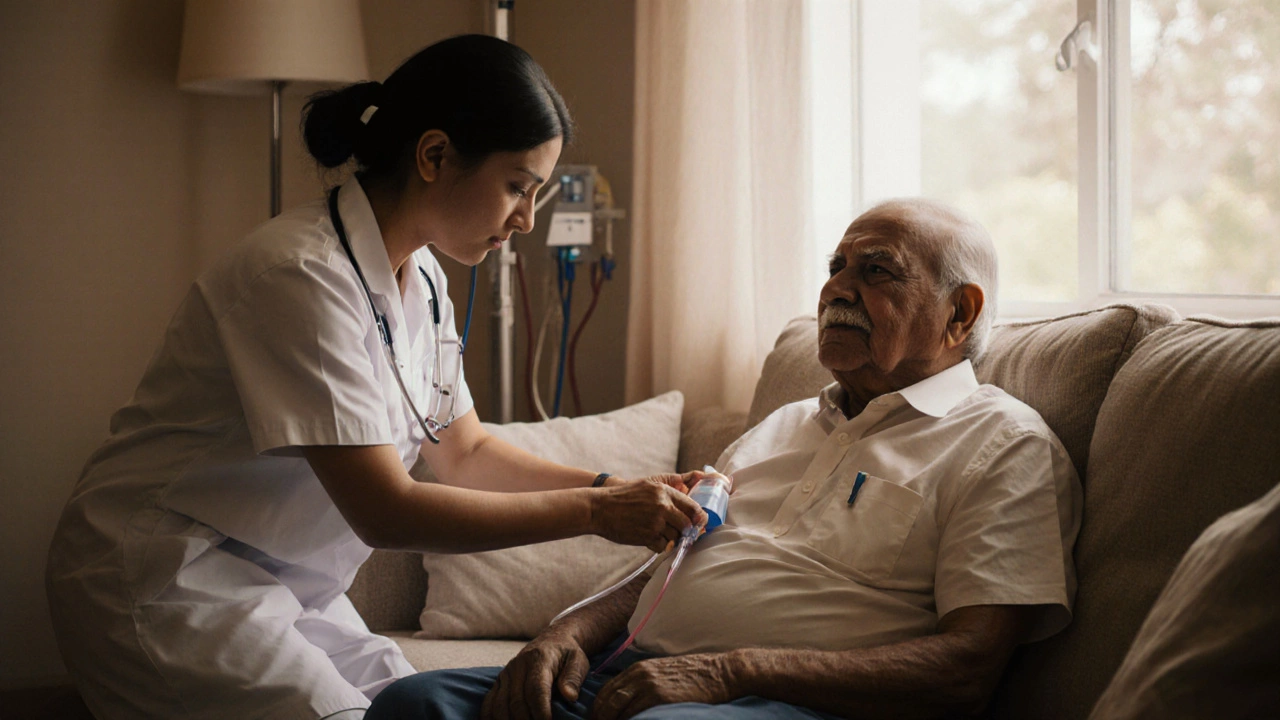Cancer Patient Needs Assessment
Physical Health Needs Highest Priority
Pain control, symptom management, and maintaining physical function are fundamental to patient comfort and treatment adherence.
- Hospital pain service
- Opioid clinic
- Physiotherapy
- Occupational therapy
- Home health aides
Emotional & Mental Health Needs High Priority
Emotional support from loved ones, professionals, and peers significantly impacts coping and overall well-being.
- Psychologist
- Peer support group
- Cognitive behavioral therapy (CBT)
- Online support communities
- Mental health counseling
Information & Communication Needs Medium Priority
Clear communication and educational resources empower patients to participate actively in their care.
- Personalized treatment roadmap
- Medical interpreters
- Health apps for symptom tracking
- Written summaries of diagnosis and treatment
- Two-way communication tools
Financial & Practical Needs High Priority
Financial burdens and logistical challenges can prevent patients from completing necessary treatments.
- Charity grants
- Government health schemes
- Volunteer driver programs
- Travel assistance
- Patient financial navigators
Nutrition & Lifestyle Support Medium Priority
Proper nutrition and lifestyle choices enhance treatment tolerance and quality of life.
- Registered dietitian
- Exercise programs
- Hydration guidance
- Acupuncture
- Mindfulness practices
Palliative & End-of-Life Care Low-Medium Priority
Early integration of palliative care improves quality of life and supports decision-making.
- Integrated palliative team
- Advance care planning
- Legal aid services
- Grief counseling
- End-of-life discussions
Patient Resource Checklist
Use this checklist to identify available resources and discuss with your healthcare team:
Talk openly with your care team about each item; many resources are hidden until you ask.
Key Takeaways
- Physical comfort, pain control and symptom management rank highest among immediate needs.
- Emotional support from family, peers and professionals is crucial for coping.
- Clear, tailored information empowers patients to make treatment decisions.
- Financial and logistical assistance often decides whether a patient can complete therapy.
- Nutrition, exercise and holistic care improve quality of life and treatment tolerance.
When a person receives a cancer diagnosis, cancer patient is an individual undergoing treatment for malignant disease, often confronting complex physical, emotional, and financial challenges. Understanding what they need most helps families, clinicians and policy makers focus help where it matters most.
Physical Health Needs
Even before the first chemotherapy cycle, pain, fatigue and nausea start to shape daily life. Effective pain management is the use of medication, nerve blocks or complementary techniques to keep pain at a tolerable level can prevent hospital readmissions and preserve independence. Clinics that provide a rapid‑response pain team reduce emergency visits by up to 30%.
Symptom control is not limited to pain. Managing fatigue means adjusting medication timing, encouraging light activity and treating anemia when present. A 2023 multicenter study found that structured exercise programs cut fatigue scores by 45% in breast‑cancer patients.
Beyond medication, patients often need help with basic activities: bathing, dressing, and mobility. Home‑health aides, physiotherapists and occupational therapists form a practical safety net that lets patients stay at home longer, a factor linked to better mental outcomes.
Emotional & Mental Health Needs
Facing mortality triggers a flood of emotions. emotional support is the provision of empathy, listening and coping tools from family, friends, counsellors or peer groups consistently ranks at the top of patient‑reported needs. In a survey of 1,200 oncology patients, 78% said having a trusted confidant reduced anxiety more than any medication.
Professional counselling, whether in‑person or via tele‑health, addresses depression, fear of recurrence and post‑traumatic stress. Cognitive‑behavioral therapy (CBT) adapted for cancer has shown a 30% drop in depressive symptoms after eight weekly sessions.
Support groups provide an added layer: sharing stories normalises fears and sparks practical tips. Online platforms, especially those moderated by oncology nurses, have grown by 150% since 2020, offering 24/7 peer connection.
Information & Communication Needs
Clarity about diagnosis, staging, treatment options and side‑effects is a cornerstone of patient empowerment. Many patients feel overwhelmed by medical jargon. Clear, written summaries and visual aids improve comprehension. A 2022 randomized trial reported that patients who received a personalized treatment roadmap were 25% more likely to adhere to oral chemotherapy schedules.
Two-way communication with the care team prevents mis‑steps. Apps that let patients log symptoms and ask questions have reduced unplanned clinic visits by 20% in a large US cancer center.
Beyond the medical team, patients need “what‑to‑expect” resources for each phase: surgery, radiation, chemotherapy, and survivorship. Checklists that cover medication timing, side‑effect monitoring and follow‑up appointments have become a simple yet powerful tool.
Financial & Practical Needs
Even in countries with public health coverage, out‑of‑pocket costs for drugs, travel and caregiving add up quickly. financial assistance refers to programs, grants or charitable funds that offset treatment‑related expenses. In India, the NCJ Cancer Aid Scheme alone helped 12% of eligible patients cover chemotherapy costs in 2024.
Practical logistics-transport to infusion centers, lodging near treatment hubs, and childcare-are equally vital. Services like hospital‑run shuttle buses or volunteer driver programs have been shown to improve appointment adherence by 18%.
Insurance navigation is a hidden need. Dedicated patient‑financial navigators can untangle claim forms, appeal denials and connect patients to co‑pay assistance. Clinics that employ a full‑time navigator report a 40% reduction in treatment delays caused by billing issues.
Nutrition & Lifestyle Support
Malnutrition worsens outcomes. nutrition counseling is personalized diet planning by a registered dietitian to meet calorie and protein goals during treatment reduces weight loss and improves tolerance to chemotherapy. Studies show a 15% increase in treatment completion rates when dietitians are part of the care team.
High‑protein, calorie‑dense foods, small frequent meals, and managing taste changes are practical tips. Hydration, especially during radiation, helps reduce skin irritation. Exercise, even low‑impact walking, maintains muscle mass and reduces fatigue. The American Cancer Society recommends at least 150 minutes of moderate activity per week for most survivors.
Holistic practices-yoga, mindfulness meditation and acupuncture-address both physical discomfort and stress. A meta‑analysis of 27 trials found acupuncture lowered chemotherapy‑induced nausea scores by 35%.

Palliative & End‑of‑Life Care Needs
When cure is no longer possible, focus shifts to quality of life. palliative care provides symptom relief, emotional support and advance‑care planning for patients with serious illness and should start early, not just at the end.
Key components include: managing pain, breathlessness, and delirium; facilitating discussions about goals of care; and supporting families through grief. Early palliative involvement has been linked to longer survival in several cancers, likely because of better symptom control and fewer aggressive, unwanted interventions.
Advance directives, living wills, and designated health proxies ensure patient wishes are respected. Education sessions with legal aid services increase completion rates from 20% to 55% in many oncology clinics.
Building a Support Network - Practical Checklist
| Need | Resource Example | How to Access |
|---|---|---|
| Pain & Symptom Control | Hospital pain service, opioid clinic | Ask treating oncologist for referral |
| Emotional Support | Psychologist, peer‑support group | Hospital social work department or online platform |
| Financial Help | Charity grants, government schemes | Contact hospital financial navigator |
| Transportation | Volunteer driver program, hospital shuttle | Register via patient services desk |
| Nutrition Guidance | Registered dietitian | Schedule through oncology clinic |
| Palliative Care | Integrated palliative team | Ask for early referral during treatment planning |
Use this checklist as a starting point. Talk openly with your care team about each item; many resources are hidden until you ask.
Frequently Asked Questions
What is the single most important need for a cancer patient?
While needs vary, effective pain and symptom control consistently emerges as the top priority because unmanaged symptoms affect every other aspect of care.
How can families help with emotional support?
Listening without judgment, attending appointments, and encouraging participation in support groups all boost morale. Simple gestures-like daily check‑ins or shared meals-have a measurable impact on anxiety levels.
Are there free resources for transportation?
Many hospitals partner with NGOs that provide volunteer drivers. In India, the Cancer Patients Aid Society runs a city‑wide shuttle service at no cost for low‑income patients.
When should a patient consider palliative care?
Palliative care can be introduced at diagnosis, especially for cancers with high symptom burden. Early involvement improves quality of life and may extend survival.
What financial aid options exist for expensive chemotherapy drugs?
Patients can explore government subsidized schemes, disease‑specific charities, and manufacturer patient‑assistance programs. A hospital financial navigator can match eligibility to the right program.
Addressing these core needs transforms a frightening journey into a manageable one. By focusing on pain control, emotional backing, clear information, financial relief, nutrition, and compassionate palliative care, we give cancer patients the best chance to live fully, whatever the outcome may be.
